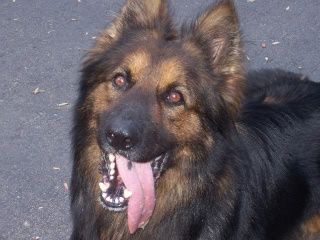Like any training exercise, there are various ways to the end; so I would like to add a few other items to Will's primer...
1) Pick a word to describe the activity. In schutzhund tracking it's "such", (pronounced -zook-) for "find". Set a routine for the activity: ie, potty the dog before starting the activity, use the same command each time, stroke before going to the scent pad...or whatever else you feel will help the dog anticipate the activity about to take place. No corrections, only encouragement.
2) Whether you are tracking for AKC or Schutzhund, the prime goal in the beginning is to teach the pup to go forward in the track. (While some trainers will do scent pads for some time, I start quickly with short tracks, once the dog has an shown interest in putting his nose to the ground.)
3) Find the right conditions so that the dog will only be successful, otherwise it's better not to start at all! You will have the best beginners success in a field with tall grass: tall enough so that you can create a visible trench with your footsteps. (Hay fields are perfect). Make a treat scent pad, and trench for some 10-15 feet, with treats placed every foot in that trench. Stay close to the dog, but stay in the trench. The goal is to teach the dog to move forward, and having tall grass on each side will discourage leaving the track. It's like tracking in a narrow canyon! No corrections, only encouragement.
4) Continue for the first 10 tracks or so to use the "canyon" concept. Eventually put in some very gentle turns. With the tall grass on each side, these turns are very obvious to the dog and he will only have success. Don't worry about tracking speed at this point, nor the finer points of straight body tracking...your goal is to teach "go forward on the track". If the dog misses a treat, do not let him go back for it. No corrections, just prevent him from turning around. Forward is the only way.
4) After successes in the grass "canyon", move to slightly shorter grass, but still make a visible trench. Each track starts with a treated scent pad. Treat every foot or so. Jackpot the end of the track. No corrections, only encouragement.
5) Now move to dirt tracking. Again choose the right conditions for the dog to have only success. Soft dirt, in which you can leave very visible footsteps. In the beginning the dog should be able to see your steps. Heel to toe, but off set like a normal walk. Treat in each foot step, with a jackpot pile of treats at the end. If you have taught him to "down", have him eat the jackpot in the down position. No corrections, only praise and encouragement.
5) From this point on, do 4 dirt tracks for every grass track. Over the next 100 tracks you do, make the them longer and longer; start spacing out the treats, making the distance between treats variable. Corners start going from gentle curves to more defined turns. Eventually you will phase out the treats altogether with only the jackpot at the end.
You can also start teaching a food motivated "down" at articles; this should be taught separately as an Obed exercise, off the track.
If you have a food motivated dog, this activity will be a cake walk!
 Previous Topic
Previous Topic Index
Index Next Topic
Next Topic













 Top
Top.jpg)


.jpg)